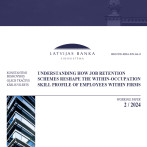The resource potential has been exhausted – for continued growth, Latvia must raise productivity
Employment has stopped rising, as was forecast before. The gradual rise in participation in the labour market (the proportion of the economically active population in the number of working age population) cannot compensate the drop in the working age population. With unemployment (10.6% or the economically active population in the third quarter) approaching its natural level, its drop rate slows down.
The average workload is also not increasing – the average length of the work week has been at the 39 hour level for the last five years. Both the average number of hours worked in the main job and the prevalence of secondary job, which ten years ago in Latvia was among the highest in Europe, dropped during the crisis and has been stable ever since. The number of people involuntarily working less than full-time has declined. Yet the prevalence of overtime is also on a decline: if ten years ago, one in three persons worked more than 41 hours per week in the main job, now that figure is one in thirteen. Apparently, as income grows, so does the value of free time and the desire and need to work overtime diminish.
There are no grounds for projecting any rapid rise in employment or workloads, and the number of economically active population will also continue to drop, therefore no substantial contribution to gross domestic product (GDP) can be expected from labour. Thus GDP growth will have to be based on rising productivity. To what extent will it be determined by investments?
The proportion of investments (gross fixed capital formation) in GDP is stable around 20 to 25%, i.e. it is greater than the European Union (EU) average and enough to compensate fixed capital depreciation and produce a slight rise. Capital growth will increase the potential GDP by about one percent per annum (Stability Programme for Latvia 2014-2017, p.67). It is doubtful that the public can accept such a small growth because it would mean that Latvia would persist in lagging behind the developed EU countries. The possibilities of raising the intensity of capital use are also limited: capacity utilization in manufacturing is close to a historical maximum.
Thus the potential GDP growth (which is estimated at 3-4% per annum for the medium term) will mostly be based on TFP (total factor productivity) growth, i.e. on new technologies, human capital, a more efficient organization of labour and corporate culture. Albeit the above cannot be defined or measured precisely, it is TFP that mainly determines the differences in productivity and income levels among countries (empirical research indicates that physical capital and quantitative human capital do not explain the bulk of differences among countries, see e.g., Hsieh un Klenow (2010), Krasnopjorovs (2012)).
For a brief period before the crisis the Latvian economy could grow on account of physical capital accumulation and after the crisis contribution was also made by an increase in capacity utilization, but now it faces a new challenge: to achieve better results with the same resources. Latvia's success in reducing the gap between its TFP and that of the more developed countries will depend on how healthy, educated and innovative we are, activating the structural reform issue.
Textual error
«… …»





